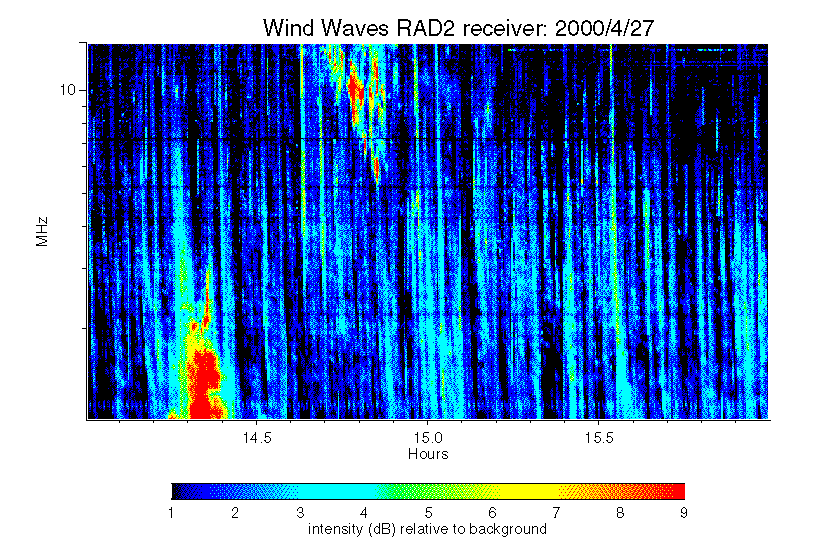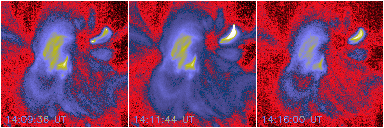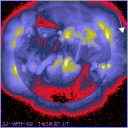
Maybe more often than not, scientific discoveries are accidental - not really guided by profound and sagacious thought logically and rationally pointing the way... The one reported here began with an e-mail from the two Mikes of the WIND/WAVES experiment, a deep-space radio observatory that often detects solar ejecta. This time the e-mail goaded us by remarking "We wish someone else had observed something at the same time." Yohkoh of course observes the Sun full-time, so why shouldn't we see something?
What WIND/WAVES saw was a remarkable storm of solar Type III bursts, resulting from bursts of weakly-relativistic electrons:

The bursts are the slightly diagonal lines, the tilt implying the velocity of the clump of electrons (typically 10% of light speed) causing the emission. This beautiful plot shows other phenomena, but the Mikes noted that Type III bursts can often be associated with "helmet" structures (cusps, in our solar X-ray jargon), which might come and go above large-scale closed magnetic loops in the lower corona.
At the same time (April 27, but really all week) we'd been seeing fascinating transequatorial loops interconnecting [the vicinities of] two major sunspot groups, as shown in a movie of the NOAA active-region data. Aha! Putting two and two together - could these transequatorial loops in fact have participated in helmet-streamer activity that could launch interplanetary particle streams? Each brightening (the idea runs) of a trans-equatorial loop might result from a reconnection episode that would accelerate an electron stream high in the corona. This sounds eminently plausible and logical, not to say important, clearly warranting a closer look. The transequatorial loops, as frequent readers will recall, have provided some of the biggest solar X-ray surprises of the current high-activity state, recently appearing as cover art for the journal Geophysical Research Letters. In the current solar maximum we seem to be getting quite a bit of interesting behavior from these large and variable loops.
On April 26, the trans-equatorial loops did something altogether wonderful, as shown at two magnification levels below:


These images cover a 25-minute interval, 14:04 to 14:29 UT, and are extracts from the normal Yohkoh synoptic movie. One sees the new formation of a bright transequatorial feature, in the form of a jet ejected from its south end; the interesting thing is the behavior of the structure at this south end. The lower of the two image sets above is 2x magnified and shows what caught the eye. The jet really appears to detach from a bright loop at the lower left, form a kink, and then re-attach itself to a different footpoint location. We were lucky enough to catch the point of origin in our higher-resolution images, as shown below:

Here the left panel shows the typical bright-footpoint beginning of a microflare; the middle panel shows the subsequent outward extension of the jet, marked by the vertical lines; and the right panel shows the disappearance of the jet (it's apparently found a happier home elsewhere!). Overall it seems to be as clear an example of large-scale magnetic reconnection as we have directly seen ("directly" meaning that we appear to see the actual re-mapping of the footpoints of coronal field lines). Of course, we need more detailed study, but this interpretation sure looks reasonable.
Because of the timing, we'd suggest that the reconnection resulted from the mass loaded into an existing large-scale structure. How the mass got ejected would be a different matter to speculate about. It's interesting to recall a pioneering article on H-alpha flare sprays by J. Warwick (ApJ 125, 811, 1957). He suggested strong coronal fields in active regions from the lack of apparent distortion of the field by the ejecta; here, since we see distortion, perhaps the field is weaker. Quick - somebody work this out!
Meanwhile, the storm of Type III bursts turned out to have a clear origin in an eruptive event from just behind the NW limb of the Sun, as shown by the arrow in the image below:

The image also shows another view of the north-south loops near disk center. So, the initial logical thought about the origin of the Type III storm turned out to be perfectly wrong, but nonetheless rewarding!
May 5 2000